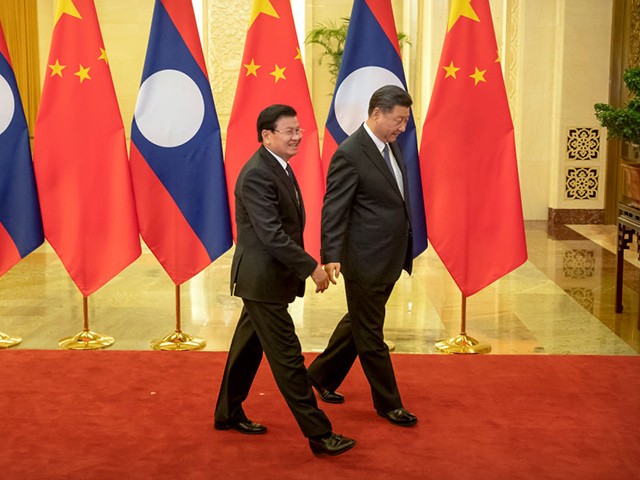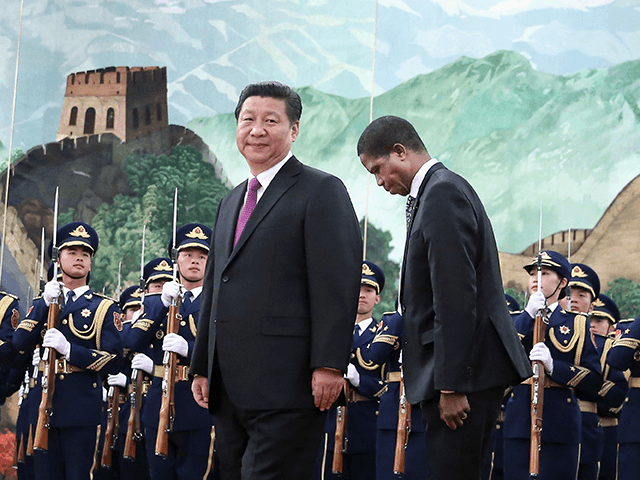According to a report published by the Green Finance and Development Center at Fudan University in Shanghai this weekend, the world’s poorest nations will pay China almost $14 billion in 2022 to service their debts.
China is now the largest single creditor for developing nations, topped only by the International Development Association (IDA) established by the World Bank in 1960. The IDA has dozens of contributing members, including the European powers, the United Kingdom, and the United States.
The Fudan University study found the world’s 68 poorest nations owe $110 billion to Chinese lenders, and the cost of servicing that debt will exceed two percent of GDP for eight of them. The most indebted nation, Angola, will spend fully five percent of its national income servicing Chinese debt this year.
The Fudan researchers suggested China “has more responsibility and opportunities” to restructure this immense debt from developing nations than any other country.

Zambia’s former President Edgar Lungu (L) shakes hands with China’s President Xi Jinping before their bilateral meeting at the Great Hall of the People on September 1, 2018. (NICOLAS ASFOURI/AFP/Getty Images)
Reporting on their findings, Bloomberg News noted that China suspended servicing charges on $2 billion in debt from poorer nations during the height of the Wuhan coronavirus pandemic, but that program ended last year.

Djibouti’s President Ismail Omar Guelleh, third from right, talks to Chinese counterpart Hu Jintao, unseen, following a welcoming ceremony at the Great Hall of the People in Beijing Wednesday, July 18, 2012. (AP Photo/Diego Azubel)
The World Bank estimated in January that 37 percent of the $35 billion in debt service owned by the world’s 74 lowest-income nations would be paid to Chinese entities.

Laos former Prime Minister Thongloun Sisoulith, left, and Chinese President Xi Jinping walk together before a meeting at the Great Hall of the People on January 6, 2020 in Beijing, China. (Photo by Mark Schiefelbein/Getty Images)
World Bank President David Malpass suggested the wealthy Western creditors of the IDA were more flexible about restructuring debt and helping poor nations make their payments than Chinese banks and private-sector lenders. Since the portion of debt from developing nations held by those flexible IDA members is now “small,” Malpass said the debt burden has become “a challenge for the world.”
The BBC in January quoted a report from the AidData project at William & Mary University that found “half of China’s lending to developing countries is not reported in official debt statistics,” so the financial situation in those countries is likely even worse than reports based on official numbers would indicate.
“There are now more than 40 low and middle-income countries, according to AidData, whose debt exposure to Chinese lenders is more than 10% of the size of their annual economic output (GDP) as a result of this ‘hidden debt,’” the BBC wrote, calculating the debt loads of Djibouti, Laos, Zambia, and Kyrgyzstan as nearly 20 percent of their annual GDP.
These bookkeeping tricks are made possible because China’s Belt and Road infrastructure loans are largely made through nominally “private” banks, so they are not reported to entities such as the World Bank and International Monetary Fund (IMF) the way government-to-government transfers would be.
“China does not publish records of its foreign loans, and the majority of its contracts contain non-disclosure clauses which prevent borrowers from revealing their contents,” the report added.
AidData spotlighted a particularly striking example of “hidden debt” to China: the $5.9 billion China-Laos railway project, which has been kept entirely off the books in Laos, but imposed unofficial debt on Laos equal to a third of its GDP.
“Beijing is more willing to bankroll projects in risky countries than other official creditors, but it is also more aggressive than its peers at positioning itself at the front of the repayment line,” AidData noted.

COMMENTS
Please let us know if you're having issues with commenting.